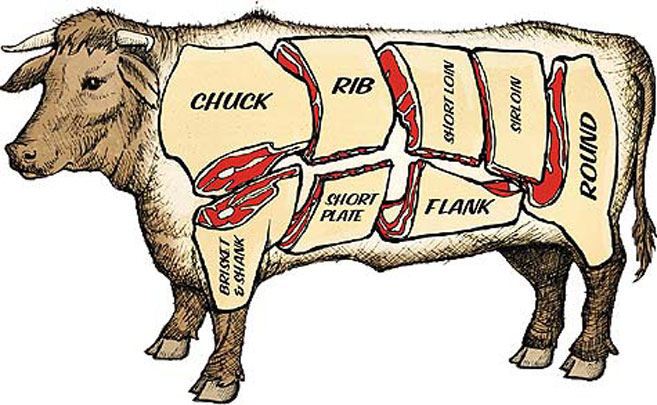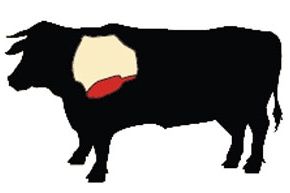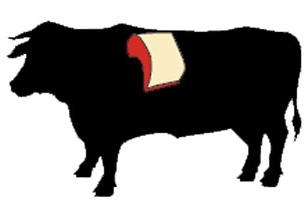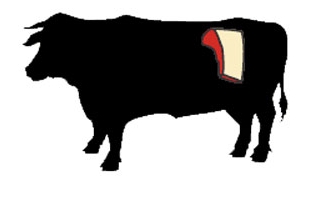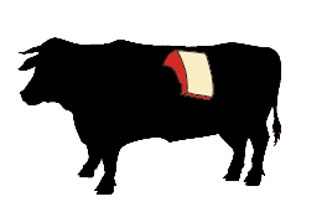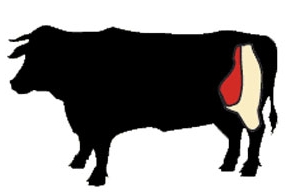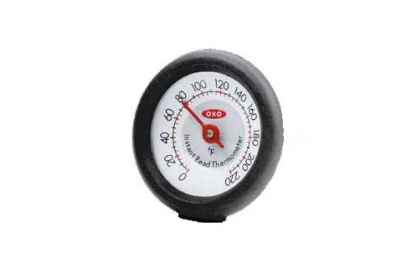The Locavore's Guide to Beef
A butcher’s eye view of what’s good to eat.
Where’s the beef? Ask a butcher that question, and he’ll want to know which beef you’re talking about. There are about 75 cuts to choose from, many of which have a variety of names, depending on how any given muscle was sectioned and where the butcher learned his trade (one man’s Kansas City steak is another man’s New York strip). How to prepare the various steaks, roasts, and ribs is a challenge as well. When to grill? When to braise? When to roast?
Beef is muscle, and how you cook it depends upon how much it was used by the cow. The front (chuck) and back (round) are oftused muscles, with plenty of connective tissue and marbleized fat (read: flavor). In general, these tougher cuts must be cooked with slow, moist heat. (Leaving bones in also adds tremendous flavor, so ask for the bones when you can.) The middle portions — where the cuts tend to be tender and more expensive — don’t involve the hard-working muscles, have a milder flavor, and can be cooked with dry heat over a shorter period of time.
Some grocery-store packaging will tell you where a cut comes from, which is helpful for something like a London broil because it can be from several different parts of the cow.
Of course, visit a neighborhood butcher or get it straight from the farm, and you can ask questions and tap into the knowledge of these seasoned experts. In the meantime, we’re providing a map of the eight “primal cuts” (the first cuts made when a butcher breaks down a steer), along with some fantastic recipes and tips from local butchers. So, you ask, where’s the beef? Hopefully, it’s in your kitchen.
BRISKET & SHANK
CUTS: Brisket, shank, soup bones
LOCATION: This is basically the cow’s breast, immediately below the chuck. The abundant fat prevents the meat from drying out.
INSIDER TIP: Many chefs swear by the brisket for ground hamburger meat, because it has a magic ratio of 30 percent fat to 70 percent protein. (Ask for some next time you’re at the local butcher shop.)
COOKING TECHNIQUES: In liquid (braise, or use a slow-cooker). Also very good when cured (smoked, pickled, etc.), as in pastrami and corned beef.
LOU LAMBERT'S COFFEE-RUBBED ROASTED BRISKET
From Whole Food Market – Austin.
Chef Lou Lambert of Lamberts Downtown Barbecue in Austin, Texas, has adapted the recipe for his famous smoked, coffee-rubbed brisket for the home kitchen by roasting the brisket rather than smoking it. Easy to assemble and cook, this brisket packs amazing flavor and can be served warm or at room temperature. The coffee rub, carrots and onions add sweetness and depth to the slow-cooked meat. The rub is equally good on chicken, pork tenderloin or ribs. To learn how to make this recipe, watch the Secret Ingredient cooking show. Secret Ingredient: Allegro Coffee (to localize this recipe, use Heine Brothers coffee in place of Allegro’s)
Serves 10 to 14
Ingredients
Coffee Rub
- 2 cups light brown sugar
- 1 cup chili powder
- ¼ cup paprika
- ¼ cup kosher salt
- ½ cup medium ground black pepper
- ¼ cup finely ground dark roast coffee
Roasting the Brisket
- 1 beef brisket, 4 to 6 pounds
- 3 large carrots, peeled and cut into pieces
- 2 yellow onions, peeled and cut into wedges
- 1½ bottles (18 ounces) dark beer
Instructions
- For the rub, combine brown sugar, chili powder, paprika, salt, pepper and coffee in a medium bowl.Stir to combine well.
- Preheat oven to 275°. Rub the brisket all over with coffee rub and set aside for 30 minutes. Store leftover coffee rub in an airtight container at room temperature. Arrange carrots and onions in the bottom of a roasting pan. Set brisket on top of vegetables.
- Pour beer over brisket and roast, 3 to 5 hours, until brisket is tender and falling apart. Allow about 45 minutes per pound of brisket. When the brisket is done, you should be able to separate the meat into shreds easily with a fork. Remove meat from roasting pan and let rest 10 to 15 minutes.
- Pour the pan juices and vegetables into a saucepan. Skim the fat off the top of the juices and discard. Slice meat across the grain and arrange on a platter. Serve juices and vegetables with meat.
CHUCK / SHOULDER
CUTS: Chuck eye roast, chuck eye steak, top blade steak, chuck pot roast, mock tender, blade roast, 7-bone roast, short ribs, flat iron steak, arm pot roast, often used for hamburger
LOCATION: The forequarter containing ribs one through five— which is basically the shoulder. It is the largest primal cut.
INSIDER TIP: The chuck contains the workhorse muscles of the cow, which gives it the most flavor. The plentiful connective tissue dissolves when the meat is slow-cooked and provides a special flavor profile.
COOKING TECHNIQUES: In liquid slow and long (i.e., braise or use a slow-cooker).
RIB
CUTS: Prime rib, rib roast (large end and small end), rib eye roast, rib eye steak, rib steak, back ribs
LOCATION: Top portion from the sixth through the 12th ribs.
INSIDER TIP: “Small end” and “large end” rib roasts refer to the size of the bones that surround it, not the actual size of the meat. The more-tender small end is actually larger than the tougher large end.
COOKING TECHNIQUES: Dry-heat cooking, including grilling, broiling, roasting, pan-frying
VALU-MARKET'S PRIME RIB ROAST
Ingredients
- 3 teaspoons grated fresh ginger root
- 1/3 cup orange marmalade
- 4 cloves garlic, minced
- 3 tablespoons soy sauce
- 2 tablespoons brown sugar
- ¼ teaspoon hot pepper sauce
- 1 tablespoon mustard powder
- 1 cup beer
- 1 (8 pound) prime rib roast
- ¼ cup olive oil
- Ground black pepper to taste
Instructions
- Mix together the ginger, marmalade, garlic, soy sauce, brown sugar, hot sauce and mustard. Stir in the beer. Prick holes all over the roast with a 2-pronged fork. Pour marinade over roast. Cover and refrigerate for at least 2 hours, basting at least twice.
- Preheat oven to 400°.
- Place roast on a rack in a roasting pan. Pour about 1 cup of marinade into the roasting pan, and discard remaining marinade. Pour olive oil over roast and season with freshly ground black pepper. Insert a roasting thermometer into the middle of the roast, making sure that the thermometer does not touch any bone. Cover roasting pan with aluminum foil and seal edges tightly around pan.
- Cook roast for 1 hour in the preheated oven. After the first hour, remove the aluminum foil. Baste, reduce heat to 325° and continue roasting for 1 more hour. The thermometer reading should be at least 140° for mediumrare, and 170° for well done. Remove roasting pan from oven, place aluminum foil over roast and let rest for about 30 minutes before slicing.
WHOLE FOODS MARKET THYME-SCENTED RIB ROAST
We know it’ll be tough, but try to be patient! Allowing this roast to rest before carving is an important step. It allows the meat to continue cooking for a few more minutes, taking it to just the right doneness, and ensures the perfect juiciness, too.
Serves 8 to 10
Ingredients
- 1 (5- to 6-pound) boneless beef rib roast
- 1 tablespoon canola or peanut oil
- 3 tablespoons chopped thyme
- Salt and pepper to taste
Instructions
- Preheat oven to 475°.
- Arrange roast in a 13- by 9-inch roasting pan and rub all over with oil, then thyme. Season generously with salt and pepper; roast for 30 minutes.
- Remove roast from oven and use a bulb baster to skim most of the fat from the pan. Baste beef with the fat remaining in pan. Reduce oven temperature to 375° and continue roasting for 1¼ to 1½ hours more, or until a meat thermometer inserted into the center of the meat registers 115°. (Meat will continue to cook while standing, reaching about 130° for medium rare.)
- Transfer roast to a platter and reserve pan juices, if desired. Let roast stand for 25 minutes, then carve.
SIRLOIN
CUTS: Sirloin steak (flat bone), sirloin steak (round bone), top sirloin steak, pin bone sirloin steak, flat bone sirloin steak, cowboy steak, tri-tip, triangle steak
LOCATION: It includes bone segments of lumbar vertebrae and is often referred to as the hip area. Not as tender as the short loin region. Has many muscle groups, which means it can be cut in a myriad of ways, resulting in a great variety of cuts.
INSIDER TIP: The quality of the fat is different here than in other parts of the cow. It can become hard after cooking, so you will need to trim it out as you’re eating — not before, or you’ll lose flavor as well.
COOKING TECHNIQUES: This region can be a little tough, but still can be prepared with some dry heat. Best to broil or pan-fry. Also makes good stew beef.
SHORT LOIN
CUTS: Boneless top loin steak*, T-bone steak, porterhouse steak, tenderloin roast (filet mignon), tenderloin steak (filet mignon).
LOCATION: The saddle section beneath the ribs, starting at the last rib (rib 13) and extending into the lumbar vertebrae. The most in-demand and expensive steaks come from this region.
INSIDER TIP: Just one example of the multitude of names for one cut of beef*: Boneless top loin steak is also known as strip steak, Kansas City Steak, New York strip steak, hotel cut strip steak, ambassador steak, or club sirloin steak. Who can keep it all straight?
COOKING TECHNIQUES: Dry-heat cooking, including grilling, broiling, roasting, pan-frying.
WHOLE FOODS MARKET ROASTED BEEF TENDERLOIN
This elegant, simple preparation for beef tenderloin is a classic. To serve a larger crowd, simply double the oil-herb rub and roast an entire beef tenderloin (3½ to 4 pounds), cut crosswise into two pieces. Use this same method to roast a whole pork loin, too. For the juiciest, most tender results, roast pork until it reaches 160°.
Serves 8 to 10
Ingredients
- 2 tablespoons olive oil, divided
- 1½ tablespoons finely chopped rosemary, divided
- ½ tablespoon finely chopped garlic
- ½ tablespoon finely chopped thyme
- 2½ teaspoons salt, divided
- ¾ teaspoon pepper, divided
- 1 (2-pound) piece beef tenderloin
- 1½ pounds small red potatoes, halved
- 5 carrots (about 1 pound), peeled and cut into thick rounds
- 1/3 cup low-sodium chicken broth
Instructions
- Preheat oven to 400°. Put 1 tablespoon of the oil, ½ tablespoon of the rosemary, garlic, thyme, 1½ teaspoons of the salt and ½ teaspoon of the pepper into a small bowl and mix well. Rub oilherb mixture all over beef tenderloin; set aside.
- Heat remaining 1 tablespoon oil in a large skillet over medium-high heat. Add beef tenderloin and cook, turning occasionally, until deep golden brown all over, about 10 minutes. Transfer beef to a large plate; set aside.
- Put potatoes, carrots, remaining 1 tablespoon rosemary, 1 teaspoon salt and ¼ teaspoon pepper into a large bowl. Drizzle any remaining drippings in skillet over potatoes and carrots and toss to combine. Transfer to a large roasting pan and spread out in an even layer; top with beef tenderloin.
- Heat same skillet over medium heat. Add broth and cook, stirring to scrape up any browned bits, for 30 seconds. Pour pan drippings over beef. Roast until a meat thermometer inserted in the thickest part of the beef registers 130°, 20 to 25 minutes.
- Transfer beef to a platter, tent with foil and set aside.
- Toss potatoes and carrots and continue to roast until tender and golden brown, about 10 minutes more. Transfer to a serving bowl. Cut beef into slices and serve with pan drippings drizzled over the top.
MIKE BEST'S MEATS STUFFED BEEF TENDERLOIN
“After 40 years in the meat business, I believe the tenderloin to be the tenderest of the cuts,and the most popular. It is not the most flavorful, although when trimmed, marinated and cooked properly it becomes a wonderful treat.”
— Bill Webb
Owner Mike Best’s Meats, Louisville, KY
Ingredients
- 1 whole beef tenderloin (5 to 6 pounds), have your butcher trim the silver skin and cut a pocket down the length of the tenderloin
- 3 cups fresh spinach, chopped
- 12 ounces fresh mushrooms, chopped
- 1 cup shredded Parmesan cheese
- Salt and pepper
- Garlic
- Olive oil
Instructions
- Combine spinach, mushrooms and Parmesan cheese and fill the pocket of the tenderloin with this mixture, then tie the roast with butcher’s twine (this will hold the pocket closed during cooking and allow for a beautiful presentation).
- Rub the outside of the tenderloin with a mixture of salt, pepper, garlic and olive oil. Place in the oven at 425° for about 15 minutes. Then remove from the oven and let the tenderloin rest on the counter while you bring the heat of your oven down to 350°. Put the tenderloin back in the oven for an additional 15 to 20 minutes. Keep in mind that each oven cooks differently. The internal temperature is to be 140° to 145°.
- Allow to cool down to room temperature before slicing.
SHORT PLATE
CUTS: Short ribs, skirt steak, hanger steak, often used for ground beef
LOCATION: More or less the area below the rib primal cut; it includes the bottom portion of ribs six through 12.
INSIDER TIP: The inexpensive skirt steak gets tough if cooked beyond medium; keep it at rare or medium rare and it remains quite tender.
COOKING TECHNIQUES: Best cooked quickly: marinated and panbroiled or grilled.
ROUND
CUTS: Top round steak or roast, bottom round roast, eye round steak or roast, heel of round, rolled rump, rump roast, round tip steak or roast, knuckle steak, cube steak, round steak, kebabs, often used for hamburger
LOCATION: Derived from a hindquarter, it is more or less the hind legs and the rump. It is the second-largest primal cut.
INSIDER TIP: There are three major muscle groups in this section: the top round, which is where a lot of London broil comes from; bottom round, which can be turned into cube steak (great for chicken-fried steak); and eye of round, which is typically a roasting cut.
COOKING TECHNIQUES: Because it doesn’t have abundant marbling, much of it needs to be cooked in liquid (braising, slow-cooker); however, some cuts are tender enough for roasting (i.e., high-quality top round, knuckle, and rump roasts).
FLANK
CUTS: Flank steak, often used for ground beef and London broil
LOCATION: Comes from the belly section of a hindquarter and has no bone segments. It can be tough because it has a lot of tissue.
INSIDER TIP: Experts recommend cutting flank steak against the grain (perpendicular to the lines) because those lines are actually long muscle fibers that are difficult to chew if not cut crosswise into smaller pieces.
COOKING TECHNIQUES: Best cooked quickly: marinated and pan-broiled or grilled. Can also be braised.
Must Have Kitchen Tools for Meat
INSTANT READ MEAT THERMOMETER
Gauging when a piece of beef is done solely by sight is difficult to impossible. A thermometer will tell you 145 degrees for medium-rare; 160 degrees for medium; and 170 degrees for well-done. Good brands include Taylor and OXO.
MEAT TENDERIZER OR POUNDER
For tougher cuts of meat (from the chuck or round, for example), a little pounding can make a big difference when it comes to tenderness. Some tenderizers even have blades that can be used to infuse the meat with garlic bits. Good brands include Jaccard and OXO
SILICONE BASTING BRUSH
Because the bristles are made of silicone, they are super easy to clean and do the job just as well (if not better) than the old kind. Good brands include OXO and Cuisipro.
MARINADE INJECTOR
This hypodermic-needle-like gadget infuses a piece of meat with your favorite marinade—and tremendous flavor. Good brands include Cajun Injector.
DUTCH OVEN
This kitchen necessity is usually made of enameled cast iron or metal and is perfect for braising and slow cooking. Good brands include Le Creuset, Staub, and All-Clad.


